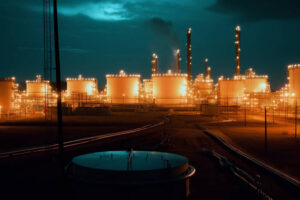The Impact of Warm Weather Forecasts on Natural Gas Prices and What It Means for Investors
Warm Weather Projections: A Major Market Influencer
As we dive into the current state of the natural gas market, it’s crucial to pay attention to the recent weather forecasts that are significantly impacting short-term demand. According to Atmospheric G2, warm weather conditions are expected across the eastern two-thirds of the United States from April 22 to April 26. This anticipated warmth is set to diminish heating demand, leading traders to feel increasingly bearish. While the market continues to stay above a critical technical level—the 200-day moving average at $2.897—it’s clear that the warmer forecasts are tempering investor enthusiasm.
The Power of Inventory Data: A Double-Edged Sword
In another recent development, the Energy Information Administration (EIA) reported a smaller-than-expected injection of +16 billion cubic feet (Bcf) for the week ending April 11. This figure is significantly below the forecast of +24 Bcf and fails to meet the five-year average increase of +50 Bcf. While this bullish surprise triggered a brief moment of short covering, it was not enough to overhaul the market’s bearish sentiment, primarily driven by those warm temperatures. Notably, as of mid-April, U.S. natural gas inventories were still 20.9% below the levels recorded a year ago and 3.9% lower than the five-year average, highlighting an underlying supply concern.
A Glance at Production and Demand Dynamics
When we look at production and demand in the Lower-48 states, we see a mixed picture that could present both opportunities and challenges for investors. On one hand, dry gas production reached 105.6 Bcf/day, marking a robust 5.4% increase year-over-year. On the other hand, demand stood at 70.1 Bcf/day, showing only a modest increase of 2.2%. It’s important to note that LNG flows to export terminals dipped to 15.5 Bcf/day, a decrease of 4.8% from the previous week.
Interestingly, there is a glimmer of hope in electricity demand; the Edison Electric Institute reported a notable 6.4% year-over-year increase in power generation for the week ending April 12. This uptick in electricity demand could signal potentially stronger natural gas consumption by utilities, creating a more complex demand landscape for investors to navigate.
Navigating the Market: What Should Investors Consider?
Given the current developments, investors should adopt a cautious yet proactive approach. While warm weather forecasts usually lead to bearish sentiment, it’s essential not to overlook the underlying supply and demand dynamics that could change the game. For example, if electricity demand continues to rise as utilities ramp up gas consumption due to lower production from other sources, we could see a more favorable outlook for natural gas prices.
At Extreme Investor Network, we believe that understanding these nuanced trends can help investors make smarter, more informed decisions. By staying ahead of the curve and analyzing both short-term fluctuations and long-term trends, investors can position themselves advantageously in this volatile market.
As always, stay tuned to our updates, as we will continue to monitor the situation closely and provide insights that are backed by our unique analyses and industry expertise. The world of trading can be unpredictable, but with the right information and strategies, you can navigate it effectively.
By focusing on a mix of market trends, expert insights, and actionable advice, Extreme Investor Network is committed to equipping you with the knowledge you need to succeed in trading and investing. Stay with us for real-time updates and analysis to help secure your financial future!

